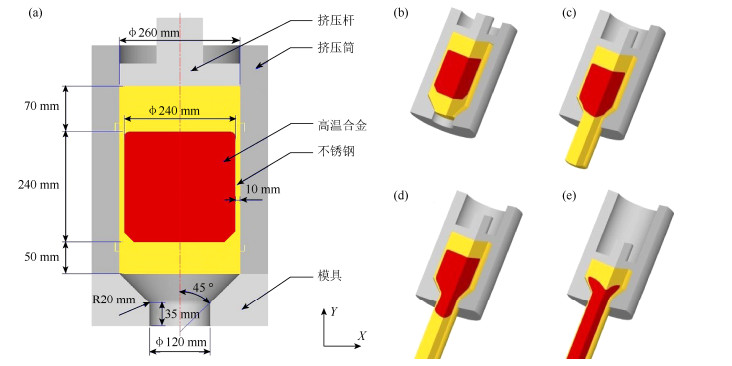| [1] |
Dever J A, Nathal M V, DiCarlo J A. Research on high-temperature aerospace materials at NASA Glenn Research Center. J Aerosp Eng, 2013, 26(2): 500 doi: 10.1061/(ASCE)AS.1943-5525.0000321
|
| [2] |
Alniak M O, Bedir F. Hot forging behavior of nickel based superalloys under elevated temperatures. Mater Des, 2010, 31(3): 1588 doi: 10.1016/j.matdes.2009.09.020
|
| [3] |
Wilkinson N A. Technological considerations in the forging of superalloy rotor parts. Met Technol, 1977, 4(1): 346 doi: 10.1179/030716977803292637
|
| [4] |
Zhang H B, Zhang K F, Jiang S S, et al. Dynamic recrystallization behavior of a γ'-hardened nickel-based superalloy during hot deformation. J Alloys Compd, 2015, 623: 374 doi: 10.1016/j.jallcom.2014.11.056
|
| [5] |
Gessinger G H, Bomford M J. Powder metallurgy of superalloys. Int Metall Rev, 1974, 19(1): 51 doi: 10.1179/095066074790136999
|
| [6] |
Coyne J E. Microstructural control in titanium-and nickel-base forgings; an overview. Met Technol, 1977, 4(1): 337 doi: 10.1179/030716977803292745
|
| [7] |
Ma W B, Liu G Q, Hu B F, et al. Prior particle boundary and its effect on tensile properties of PM FGH96 superalloy. Mater Sci Eng Powder Metall, 2013, 18(1): 1 doi: 10.3969/j.issn.1673-0224.2013.01.003马文斌, 刘国权, 胡本芙, 等. 粉末高温合金FGH96中的原始粉末颗粒边界及其对合金拉伸断裂行为的影响. 粉末冶金材料科学与工程, 2013, 18(1): 1 doi: 10.3969/j.issn.1673-0224.2013.01.003
|
| [8] |
Liu C Z, Liu F, Huang L, et al. Effect of hot extrusion and heat treatment on microstructure of nickel-base superalloy. Trans Nonferrous Met Soc China, 2014, 24(8): 2544 doi: 10.1016/S1003-6326(14)63381-1
|
| [9] |
Chen L, Zhao G Q, Yu J Q, et al. Constitutive analysis of homogenized 7005 aluminum alloy at evaluated temperature for extrusion process. Mater Des, 2015, 66: 129 doi: 10.1016/j.matdes.2014.10.045
|
| [10] |
Bai Q, Lin J, Jiang J, et al. A study of direct forging process for powder superalloys. Mater Sci Eng A, 2015, 621: 68 doi: 10.1016/j.msea.2014.10.039
|
| [11] |
Zhang M, Liu G Q, Hu B F. Effect of microstructure instability on hot plasticity during thermomechanical processing in PM nickel-based superalloy. Acta Metall Sinica, 2017, 53(11): 1469 doi: 10.11900/0412.1961.2017.00172张明, 刘国权, 胡本芙. 镍基粉末高温合金热加工变形过程中显微组织不稳定性对热塑性的影响. 金属学报, 2017, 53(11): 1469 doi: 10.11900/0412.1961.2017.00172
|
| [12] |
Semiatin S L, Shank J M, Shiveley A R, et al. The effect of forging variables on the supersolvus heat-treatment response of powder-metallurgy nickel-base superalloys. Metall Mater Trans A, 2014, 45(13): 6231 doi: 10.1007/s11661-014-2572-y
|
| [13] |
Wu K, Liu G Q, Hu B F, et al. Characterization of hot deformation behavior of a new Ni–Cr–Co based P/M superalloy. Mater Charact, 2010, 61(3): 330 doi: 10.1016/j.matchar.2009.12.013
|
| [14] |
Ning Y Q, Yao Z K, Lei Y Y, et al. Hot deformation behavior of the post-cogging FGH4096 superalloy with fine equiaxed microstructure. Mater Charact, 2011, 62(9): 887 doi: 10.1016/j.matchar.2011.06.004
|
| [15] |
He G A, Liu F, Si J Y, et al. Characterization of hot compression behavior of a new HIPed nickel-based P/M superalloy using processing maps. Mater Des, 2015, 87: 256 doi: 10.1016/j.matdes.2015.08.035
|
| [16] |
Immarigeon J A, Floyd P H. Microstructural instabilities during superplastic forging of a nickel-base superalloy compact. Metall Trans A, 1981, 12(7): 1177 doi: 10.1007/BF02642331
|
| [17] |
Semiatin S L, McClary K E, Rollett A D, et al. Plastic flow and microstructure evolution during thermomechanical processing of a PM nickel-base superalloy. Metall Mater Trans A, 2013, 44(6): 2778 doi: 10.1007/s11661-013-1675-1
|
| [18] |
Wu K, Liu G Q, Hu B F, et al. Effect of processing parameters on hot compressive deformation behavior of a new Ni–Cr–Co based P/M superalloy. Mater Sci Eng A, 2011, 528(13-14): 4620 doi: 10.1016/j.msea.2011.02.051
|
| [19] |
Zhang B J, Zhao G P, Zhang W Y, et al. Deformation mechanisms and microstructural evolution of γ + γ' duplex aggregates generated during thermomechanical processing of nickel-base superalloys // Proceedings of the 13th International Symposium on Superalloys. Seven Springs, PA, 2016: 487
|
| [20] |
Semiatin S L, Kim S L, Zhang F, et al. An investigation of high-temperature precipitation in powder-metallurgy, gamma/gamma-prime nickel-base superalloys. Metall Mater Trans A, 2015, 46(4): 1715 doi: 10.1007/s11661-015-2748-0
|




 下载:
下载:









